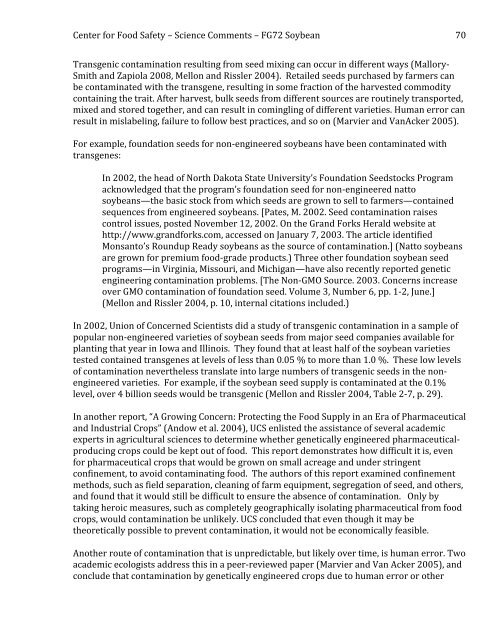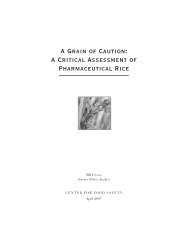a four-fold rise - Center for Food Safety
a four-fold rise - Center for Food Safety
a four-fold rise - Center for Food Safety
Create successful ePaper yourself
Turn your PDF publications into a flip-book with our unique Google optimized e-Paper software.
<strong>Center</strong> <strong>for</strong> <strong>Food</strong> <strong>Safety</strong> – Science Comments – FG72 Soybean <br />
70 <br />
Transgenic contamination resulting from seed mixing can occur in different ways (Mallory-‐<br />
Smith and Zapiola 2008, Mellon and Rissler 2004). Retailed seeds purchased by farmers can <br />
be contaminated with the transgene, resulting in some fraction of the harvested commodity <br />
containing the trait. After harvest, bulk seeds from different sources are routinely transported, <br />
mixed and stored together, and can result in comingling of different varieties. Human error can <br />
result in mislabeling, failure to follow best practices, and so on (Marvier and VanAcker 2005). <br />
For example, foundation seeds <strong>for</strong> non-‐engineered soybeans have been contaminated with <br />
transgenes: <br />
In 2002, the head of North Dakota State University’s Foundation Seedstocks Program <br />
acknowledged that the program’s foundation seed <strong>for</strong> non-‐engineered natto <br />
soybeans—the basic stock from which seeds are grown to sell to farmers—contained <br />
sequences from engineered soybeans. [Pates, M. 2002. Seed contamination raises <br />
control issues, posted November 12, 2002. On the Grand Forks Herald website at <br />
http://www.grand<strong>for</strong>ks.com, accessed on January 7, 2003. The article identified <br />
Monsanto’s Roundup Ready soybeans as the source of contamination.] (Natto soybeans <br />
are grown <strong>for</strong> premium food-‐grade products.) Three other foundation soybean seed <br />
programs—in Virginia, Missouri, and Michigan—have also recently reported genetic <br />
engineering contamination problems. [The Non-‐GMO Source. 2003. Concerns increase <br />
over GMO contamination of foundation seed. Volume 3, Number 6, pp. 1-‐2, June.] <br />
(Mellon and Rissler 2004, p. 10, internal citations included.) <br />
In 2002, Union of Concerned Scientists did a study of transgenic contamination in a sample of <br />
popular non-‐engineered varieties of soybean seeds from major seed companies available <strong>for</strong> <br />
planting that year in Iowa and Illinois. They found that at least half of the soybean varieties <br />
tested contained transgenes at levels of less than 0.05 % to more than 1.0 %. These low levels <br />
of contamination nevertheless translate into large numbers of transgenic seeds in the non-engineered<br />
varieties. For example, if the soybean seed supply is contaminated at the 0.1% <br />
level, over 4 billion seeds would be transgenic (Mellon and Rissler 2004, Table 2-‐7, p. 29). <br />
In another report, “A Growing Concern: Protecting the <strong>Food</strong> Supply in an Era of Pharmaceutical <br />
and Industrial Crops” (Andow et al. 2004), UCS enlisted the assistance of several academic <br />
experts in agricultural sciences to determine whether genetically engineered pharmaceutical-producing<br />
crops could be kept out of food. This report demonstrates how difficult it is, even <br />
<strong>for</strong> pharmaceutical crops that would be grown on small acreage and under stringent <br />
confinement, to avoid contaminating food. The authors of this report examined confinement <br />
methods, such as field separation, cleaning of farm equipment, segregation of seed, and others, <br />
and found that it would still be difficult to ensure the absence of contamination. Only by <br />
taking heroic measures, such as completely geographically isolating pharmaceutical from food <br />
crops, would contamination be unlikely. UCS concluded that even though it may be <br />
theoretically possible to prevent contamination, it would not be economically feasible. <br />
Another route of contamination that is unpredictable, but likely over time, is human error. Two <br />
academic ecologists address this in a peer-‐reviewed paper (Marvier and Van Acker 2005), and <br />
conclude that contamination by genetically engineered crops due to human error or other







